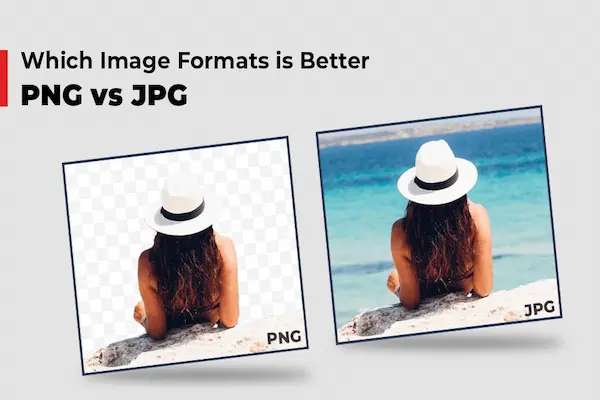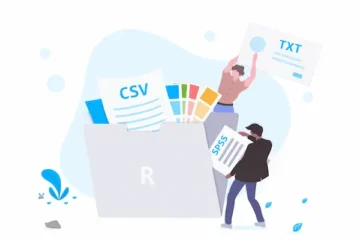PNG or JPG? Which Image Format Should You Use?
PNG vs. JPG: Discover the key differences, best uses, and how to choose the right image format for your needs.
Understanding Image Compression: The Foundation of Format Differences
The fundamental difference between PNG and JPG lies in their approach to compression – the process of reducing file sizes while attempting to maintain acceptable image quality.
JPG (JPEG) uses lossy compression, which permanently removes image data deemed less important by complex algorithms, achieving dramatic file size reductions at the cost of some image quality degradation (source: Adobe – JPEG vs. PNG comparison).
PNG employs lossless compression, preserving every pixel of original image data while still reducing file sizes through efficient data organization, resulting in perfect image quality but larger file sizes.
Lossy compression makes irreversible changes to image data, meaning each time you save a JPG, quality potentially degrades further, while PNG files can be opened, edited, and re-saved without any quality loss.
The compression algorithms work differently: JPG divides images into 8×8 pixel blocks and analyzes color and brightness variations, while PNG uses prediction algorithms and data compression techniques similar to ZIP files.
Understanding compression trade-offs helps explain why JPG excels for photographs with millions of colors and gradual transitions, while PNG performs better for graphics with sharp edges, solid colors, and transparency requirements.
Compression artifacts – visual distortions introduced by lossy compression – appear differently in JPG files: blocking, color banding, and blur around sharp edges, while PNG files are immune to compression artifacts entirely.

PNG Format Deep Dive: When Perfection Matters Most
PNG (Portable Network Graphics) was designed specifically to overcome limitations of older formats while providing the highest possible image quality for digital applications.
The format supports true transparency through alpha channels, allowing parts of images to be completely transparent or semi-transparent, essential for logos, icons, and graphics that overlay other content.
PNG handles sharp edges and solid colors exceptionally well, making it ideal for screenshots, diagrams, logos, illustrations, and any image where crisp detail preservation is more important than file size.
Color depth support in PNG is extensive, handling everything from simple black-and-white images to full 24-bit color with 8-bit transparency, providing flexibility for various graphic design needs.
Text within images remains perfectly readable in PNG format because the lossless compression preserves the sharp contrast between text and background without introducing blur or artifacts.
PNG files support gamma correction and color profile embedding, ensuring consistent color appearance across different devices and displays when color accuracy is critical.
The format excels in digital-native workflows where images will be viewed on screens rather than printed, optimizing for pixel-perfect display rather than print reproduction (source: TechSmith – JPG vs. PNG comparison).
JPG Format Analysis: Optimized for Photographic Content
JPG compression algorithms were specifically designed to take advantage of human visual perception limitations, removing information that eyes typically don’t notice in photographic images.
The format excels at handling photographs with millions of colors, gradual color transitions, natural lighting, and organic shapes where minor quality reduction isn’t visually obvious to most viewers.
Adjustable compression levels in JPG allow you to balance file size against image quality, providing control over the trade-off between storage efficiency and visual fidelity for specific applications.
Color information handling in JPG uses subsampling techniques that reduce color detail while preserving brightness information, working well for natural images but poorly for graphics with precise color requirements.
Metadata support in JPG files can include camera settings, GPS coordinates, timestamps, and other information embedded within the file, valuable for photography workflow management and organization.
Wide compatibility makes JPG the most universally supported image format, displaying correctly across virtually all devices, browsers, and software applications without compatibility concerns.
The format’s efficiency makes it ideal for situations where file size directly impacts performance: web pages, email attachments, mobile applications, and any context where bandwidth or storage limitations are significant factors.
Quality vs. File Size: Understanding the Fundamental Trade-Off
The choice between PNG and JPG often comes down to prioritizing either maximum quality or minimum file size, with each format optimized for different priorities.
JPG files typically achieve 5-15 times smaller file sizes compared to equivalent PNG files for photographic content, dramatically reducing storage requirements and transfer times (source: Shopify – JPG vs PNG guide).
For web applications, smaller file sizes translate directly to faster loading times, reduced bandwidth consumption, improved user experience, and better search engine optimization through page speed factors.
PNG’s larger file sizes become worthwhile when image quality degradation would be professionally unacceptable: company logos, technical diagrams, screenshots with text, or any image requiring pixel-perfect reproduction.
Storage cost considerations multiply across large image collections – choosing JPG over PNG for appropriate images can reduce storage requirements and associated costs by 80-90% in many cases.
Mobile device considerations are particularly important, as larger PNG files consume more device storage and cellular data, potentially impacting user experience and data plan costs.
The quality difference becomes more noticeable when images are displayed at larger sizes, printed, or used in professional contexts where image degradation reflects poorly on brand quality or technical competence.
Web Performance Impact: Loading Speed and User Experience
Image format choice significantly affects website performance metrics that influence user engagement, search engine rankings, and overall digital experience quality.
Loading time differences can be substantial: a 2MB PNG file might load in 8-10 seconds on slower connections, while an equivalent 200KB JPG loads in under a second, dramatically affecting user patience and engagement.
Mobile performance impact is amplified because mobile users often have slower, less reliable connections and limited data plans that make large PNG files particularly problematic for user experience.
Search engines like Google consider page loading speed as a ranking factor, making efficient image format selection an important component of search engine optimization strategy.
Content Delivery Network (CDN) costs scale with data transfer volume, meaning PNG files cost significantly more to serve to users compared to optimized JPG files across large-scale applications.
User engagement metrics show that pages loading in under 3 seconds maintain significantly higher engagement rates, making image optimization through format selection crucial for business websites and applications.
Progressive JPG loading allows images to appear gradually as data loads, providing better perceived performance compared to PNG files that must load completely before displaying any content.
Transparency Requirements: When PNG Becomes Essential
Transparency support represents PNG’s most distinctive advantage, enabling sophisticated graphic design and web development techniques impossible with JPG format.
Logo applications require transparency to overlay cleanly on various backgrounds, making PNG the only viable choice for professional branding materials used across different contexts and color schemes.
Web design transparency allows for complex layering effects, drop shadows, gradient overlays, and sophisticated visual compositions that enhance modern website aesthetics and user interface design.
Icon design relies heavily on transparency for integration into different themes, operating systems, and application interfaces where background colors change dynamically or vary by user preference.
Watermark applications benefit from semi-transparency effects that protect copyrighted images while maintaining visibility of underlying content, achievable only through PNG’s alpha channel support.
E-commerce product photography often requires transparency for clean presentation against various background colors, allowing customers to focus on products without distracting backgrounds.
Print design workflows use transparency for complex compositions where elements overlap, require knockout effects, or need to integrate seamlessly with variable background content in layouts.
Professional Use Cases: Industry-Specific Format Recommendations
Different industries and professional contexts have developed best practices around image format selection based on specific quality requirements, workflow needs, and output destinations.
Photography professionals typically use JPG for final delivery due to universal compatibility and reasonable file sizes, while maintaining RAW files for editing and PNG for any images requiring transparency or text overlay.
Graphic designers choose PNG for logos, icons, illustrations, and any graphics requiring sharp edges or transparency, switching to JPG only for photographic elements where file size outweighs quality concerns.
Web developers optimize format selection based on content type: PNG for user interface elements, logos, and graphics with text, JPG for hero images, photo galleries, and decorative photographic content.
E-commerce applications typically use JPG for product photography to minimize loading times while using PNG for product logos, badges, and any overlay elements requiring transparency.
Marketing professionals balance format selection based on distribution channel: PNG for high-quality print materials and presentations, JPG for email campaigns and social media where file size affects deliverability and engagement.
Medical and scientific imaging often requires PNG to preserve diagnostic image quality without compression artifacts that might affect analysis or diagnosis accuracy.
Technical Specifications and Browser Compatibility
Understanding technical capabilities helps ensure your image format choices work correctly across different platforms, browsers, and viewing contexts.
PNG supports color depths from 1-bit black and white to 48-bit color with 16-bit transparency, providing flexibility for various applications from simple graphics to high-end photographic work.
JPG is limited to 8-bit color depth (256 levels per channel) but supports CMYK color space for print applications, making it suitable for professional printing workflows with proper color management.
Browser support for both formats is universal across modern browsers, but older systems might handle PNG transparency differently, requiring testing across target audience devices and browsers.
Progressive enhancement techniques allow websites to serve optimized formats to capable browsers while providing fallback options for older systems or specific use cases requiring maximum compatibility.
File size limits vary by platform: some email systems restrict attachment sizes, social media platforms compress images automatically, and content management systems may have upload restrictions affecting format viability.
Metadata preservation differs between formats: JPG retains extensive camera and editing information, while PNG supports basic metadata but focuses primarily on image data rather than comprehensive file information.
Future-Proofing Your Image Strategy
Emerging image formats and changing web standards require considering how current format choices will perform in evolving technological landscapes.
WebP and AVIF represent next-generation formats offering better compression than JPG with PNG-like features, though adoption remains limited compared to universal PNG and JPG support.
Mobile-first design trends emphasize performance optimization, potentially favoring JPG for most applications while reserving PNG for essential transparency and quality-critical graphics.
High-resolution displays and retina screens may influence format selection as users expect sharper images, potentially increasing the value of PNG’s quality preservation for certain applications.
Bandwidth improvements and storage cost reductions might make PNG’s quality advantages more attractive over time, though current performance considerations still favor JPG for large-scale applications.
Automated optimization tools are increasingly handling format selection intelligently, potentially reducing the need for manual format decisions while improving overall performance across diverse content types.
Content management systems are implementing smart format selection that automatically chooses optimal formats based on image content, viewing context, and performance requirements, streamlining workflow decisions.
Making the Right Choice: Decision Framework and Best Practices
Developing a systematic approach to format selection ensures consistent, optimal results across different projects and applications.
Content analysis should be your first step: photographs and natural images typically favor JPG, while graphics, logos, screenshots, and illustrations usually perform better as PNG files.
Quality requirements assessment helps determine whether compression artifacts are acceptable: professional presentations and branding materials typically require PNG quality, while casual web content may accept JPG trade-offs.
Performance constraints evaluation considers loading speed requirements, storage limitations, bandwidth costs, and user experience priorities that might override pure quality considerations.
Distribution context affects format choice: email attachments favor smaller JPG files, while website headers might justify PNG for visual impact, and print materials require format-specific optimization.
Audience considerations include target device types, connection speeds, data plan limitations, and technical sophistication that affect how format choices impact user experience.
Long-term usage planning considers whether images will be re-edited, resized, or repurposed in ways that favor PNG’s non-destructive characteristics over JPG’s compression efficiency.
By systematically evaluating these factors for each image use case, you can make informed format decisions that optimize the balance between visual quality, performance, and practical constraints for your specific needs and goals.




